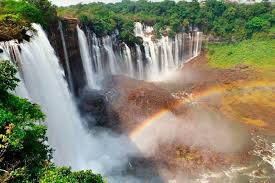Cangandala National Park , Angola
🦌 Cangandala National Park: Angola’s Hidden Wildlife Sanctuary
Nestled in the heart of Malanje Province, Cangandala National Park is Angola's smallest national park, yet it boasts a rich tapestry of biodiversity and natural beauty. Established in 1963 and granted national park status in 1970, Cangandala was primarily created to protect the Giant Sable Antelope (Hippotragus niger variani), an endangered species and a national symbol of Angola. Wikipedia+6Wikipedia+6Global National Parks+6
🌍 Location & Access
-
Coordinates: Approximately 9°48′S 16°45′E
-
Area: Covers about 630 km², making it the smallest national park in Angola.
-
Proximity: Located about 50 km south of Malanje city, easily accessible by road.Wikipedia+1hoteisangola.com+1keybiodiversityareas.org+10Wikipedia+10Wikipedia+10
🦓 Wildlife & Flora
🐾 Notable Species
-
Giant Sable Antelope: The park's flagship species, with a population that has rebounded from near extinction.
-
Other Mammals: Includes species like the Defassa Waterbuck, Bushbuck, Crowned Duiker, Sitatunga, and Puku.
-
Birdlife: Home to a variety of bird species, including the Guinea Turaco, Pale-billed Hornbill, and Miombo Tit.
-
Reptiles & Amphibians: Hosts 27 reptile and 21 amphibian species, contributing to its rich biodiversity. Wikipedia+1Wikipedia+1nationalparks.africa+1africatouroperators.org+1
🌿 Vegetation
-
Dominant Flora: The park features miombo woodlands, characterized by Brachystegia and Julbernardia trees, interspersed with patches of grasslands and papyrus swamps along riverbanks.
-
Climate: Receives approximately 1,350 mm of rainfall annually, with an average temperature of 21.5°C (71°F). Wikipedia+4nationalparks.africa+4africatouroperators.org+4Wikipedia+2Wikipedia+2Wikipedia+2
🥾 Activities & Attractions
-
Wildlife Viewing: Spot the elusive Giant Sable Antelope and other native species in their natural habitat.
-
Birdwatching: Ideal for observing a diverse range of bird species, especially during migratory seasons.
-
Hiking: Explore the park's varied terrain, including savannas and woodlands, on guided treks.
-
Photography: Capture the stunning landscapes and diverse wildlife, making it a haven for photographers.africatouroperators.org+2Global National Parks+2nationalparks.africa+2
🗓️ Best Time to Visit
-
Dry Season (May–October): Offers optimal conditions for wildlife viewing and hiking, with clearer trails and less dense vegetation.
-
Wet Season (November–April): The landscape becomes lush and vibrant, though some areas may be less accessible due to rainfall.
🏨 Accommodation & Travel Tips
-
Nearby Accommodations: While the park itself doesn't offer lodging, Malanje city provides various options ranging from guesthouses to hotels.
-
Guided Tours: Hiring a local guide is recommended to enhance your experience and ensure safety.
-
Travel Essentials: Bring essentials like insect repellent, sturdy footwear, and sufficient water.
📸 Photo Opportunities
-
Giant Sable Antelope: Capture this majestic creature in its natural environment.
-
Scenic Landscapes: Photograph the park's diverse ecosystems, from woodlands to riverine areas.
-
Birdlife: Ideal for bird enthusiasts looking to document a variety of species.


